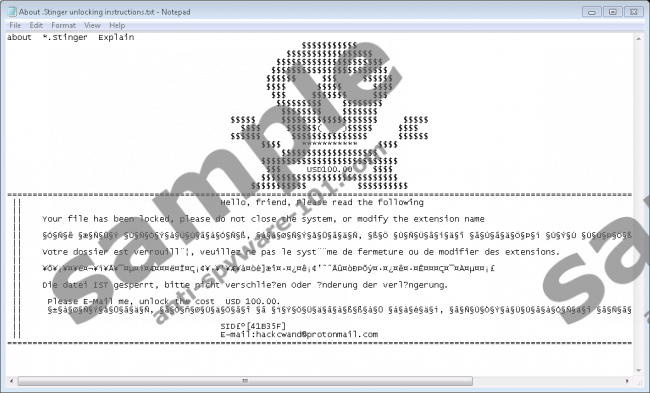What is Stinger Ransomware?
Stinger Ransomware is a harmful file-encrypting application that may encipher user’s data and then show a ransom note asking to pay for its decryption. Our researchers at Anti-spyware-101.com say you can quickly recognize the threat if you take a look at the encrypted files’ titles. Provided, they are enciphered by this malware they should be marked with .Stinger extension, e.g., roses.jpg.Stinger. According to the ransom note, the infection’s creators want about one hundred US dollars, but we would not recommend paying it as there are no guarantees they will help you decrypt your files. For those who do not wish to lose their money in vain, we advise erasing Stinger Ransomware at once. Later on, if you made any backup copies before the malicious application appeared, you could use them to recover encrypted files instead of dealing with the hackers. Those who would like to try to remove it manually could follow the instructions available below, although if the steps seem a bit difficult for you keep it in mind, it might be safer to use a legitimate antimalware tool instead.

Where does Stinger Ransomware come from?
Same as many other similar malicious applications we believe Stinger Ransomware might be distributed with infected email attachments, fictitious installers, and so on. In other words, it is possible you could have encountered it after opening a suspicious email attachment that came from an unknown sender or launching a malicious installed downloaded from untrustworthy file-sharing web pages. Thus, naturally, to prevent similar threats from entering the system you should be more cautious with unreliable email attachments and do your best to keep away from torrent and other doubtful file-sharing web pages. Besides, our researchers recommend choosing a legitimate antimalware tool and installing it on the computer. It might help you recognize potential threats and keep the system safe.
How does Stinger Ransomware work?
The malicious application does not create any additional data on the system except the ransom note. In other words, besides the malware’s installer, there should be no other files belonging to it on the computer. This means Stinger Ransomware might start the encryption process the minute the user opens its installer. Our researchers learned the threat could encipher various private user’s files, such as photos, videos, different types of documents, archives, and so on. Just as explained earlier, during the encryption process, all affected files should be marked with .Stinger extension by applying it at the end of the title. Once the infection ends enciphering your data, it should drop a text document called “About .Stinger unlocking instructions.txt.”
Inside of the malware’s ransom note (About .Stinger unlocking instructions.txt), the user should find the same sentence written in three different languages. The English one says: “Your file has been locked, please do not close the system, or modify the extension name.” Then the message should inform the victim he has to pay about one hundred US dollars for decryption, but first, contact the cybercriminals behind Stinger Ransomware via email (hackcwand@protonmail.com). As we already explained, there are no guarantees these people will hold on to their promises, which is why we advise against paying the ransom. Not to mention, if you have backup copies somewhere safe, you do not need to decrypt any data as you can replace it with copies.
How to remove Stinger Ransomware?
Users who choose to eliminate Stinger Ransomware manually should follow the instructions available at the end of this paragraph as they will explain what to do to in detail. The other way to get rid of this malicious application is to employ a legitimate antimalware tool, perform a full system-scan, and then press the provided deletion button to remove the malware and all other possible threats at once.
Erase Stinger Ransomware
- Press Ctrl+Alt+Delete.
- Select Task Manager.
- Search for the malware’s process.
- Select this process and click End Task.
- Leave Task Manager.
- Tap Windows key+E.
- Navigate to the following paths:
%TEMP%
%USERPROFILE%\desktop
%USERPROFILE%\downloads - Find the file that infected the device.
- Right-click the malicious file and press Delete.
- Locate a file titled About .Stinger unlocking instructions.txt, right-click it and press Delete.
- Close File Explorer.
- Empty your Recycle bin.
- Restart the system.
100% FREE spyware scan and
tested removal of Stinger Ransomware*





0 Comments.